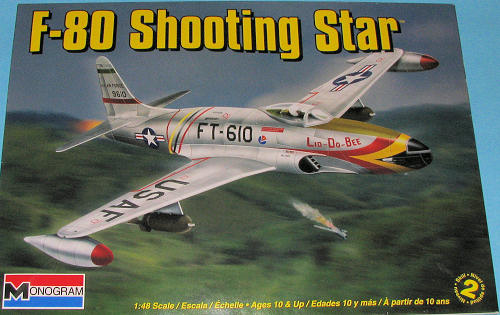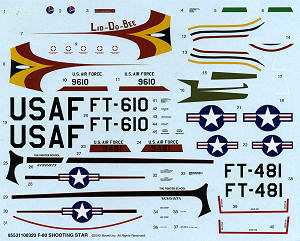
Monogram 1/48 F-80 Shooting Star
| KIT #: | 85-5311 |
| PRICE: | $20.98 |
| DECALS: | Two options |
| REVIEWER: | Scott Van Aken |
| NOTES: | Reissue of 1977 kit |

| HISTORY |
The Lockheed P-80 Shooting Star was the first jet fighter used operationally by the United States Army Air Forces, and saw extensive combat in Korea with the United States Air Force as the F-80. As one of the world's first successful turbojet-powered combat aircraft, it helped usher in the "jet age" in the USAF and other air forces worldwide. One of its claims to fame is in training a new generation of pilots, especially in its closely-related, and actually faster, T-33 Shooting Star trainer development.
Shooting Stars first saw combat service in the Korean War, employing both the F-80C variant and RF-80 photo-recon variants. The first jet-versus-jet aircraft battle took place on 8 November 1950 in which Lieutenant Russell J. Brown, flying an F-80, claimed a MiG-15 shot down. Despite the initial claim of success, the straight-wing F-80s were inferior in performance to the MiGs and were soon replaced in the air superiority role by the swept-wing F-86 Sabre. When sufficient Sabres were in operation, the Shooting Star was assigned to ground attack missions, advanced flight training duties and air defense in Japan. By the end of hostilities the only F-80s still flying in Korea were photo-recon variants.
F-80Cs equipped ten USAF squadrons in Korea:
Of the 277 F-80s lost in operations (approximately 30% of the existing inventory), 113 were destroyed by ground fire and 14 shot down by enemy aircraft. F-80s are credited by the USAF with destroying 17 aircraft in air-to-air combat and 24 on the ground. MajorCharles J. Loring, Jr. was posthumously awarded the Medal of Honor for his actions while flying with the 80th Fighter-Bomber Squadron, 8th Fighter-Bomber Wing on 22 November 1952.
| THE KIT |
 According to the copyright marking under the tailplane, this kit was initially issued in 1977. Though sporadically released over the last 30 years or so, it has remained a popular kit with modelers as it is the only 1/48 F-80 kit that I know of. Amazing, but true.
According to the copyright marking under the tailplane, this kit was initially issued in 1977. Though sporadically released over the last 30 years or so, it has remained a popular kit with modelers as it is the only 1/48 F-80 kit that I know of. Amazing, but true.
1977 was a time of raised panel lines and the need for detail from the Monogram-buying crowd and that is what they got with this one. There is a full engine, a tail stand for the separate rear fuselage so one can display it with the tail off, an opening nose gun bay with full weapons and a nicely detailed cockpit where one can have the canopy opened to show the work done there. The kit also comes with bomb racks and a pair of bombs or napalm tanks as well as two different styles of wing tip drop tanks that includes the Korean War era 'Misawa' tanks that allowed the planes to fly from Japan, do their mission and return. The kit also includes a seated pilot, something of a staple with Monogram kits. I notice that the nose wheel is the early type while the main wheels are the later 'fluted' variety. It may be worthwhile to do a reference check to see if any aftermarket wheels may be required for the aircraft you are modeling.
As to the plastic itself, it is in a darkish grey (not the silver we were so used to seeing) and I have to say that the molds have held up well over the years and there is very little in the way of flash. There are some sink areas on the outside of the separate flaps, the fuselage opposite where there are thick alignment runs on the inside and where there are alignment pins/receptacles. They are also on the outside of gear doors and on the intake blanking pieces. I also found the usual ejector pin marks on pretty much every piece. These will only be a problem on the inside of the gear doors, inside of the flaps. The worst are those on the underside of the tailplanes where there are divots of a goodly depth that will have to be filled in. I know it sounds like a lot, but this is pretty much the norm for kits from this time.
 Instructions are well done with both generic and FS 595 paint references. If you have ever built a Monogram kit, then you will know how nicely their instructions are. There are markings for two planes. One is the box art aircraft of LtC Oliver Cellini, of the 25 FIS/51FIW in October of 1950. The other is from the Acrojets display team at Williams AFB in 1949. s. These are both in unpainted metal. The decal sheet is superbly printed and appears to be completely in register. There is a full set of data stencils and the instructions provide placement data. On both schemes, the nose will need to be painted to match the decal. You will notice that the kit decals do not have the really bright red that is shown on the box art or the built up kit on the side of the box. Checking with my full color reference, "F-80 Shooting Star Units over Korea", none of the 25 FIS planes pictured had this wine colored red. However, I have learned not to say 'Never', and this particular plane was not shown. These do not appear to be Cartograf decals so may have been printed in the US or even in China.
Instructions are well done with both generic and FS 595 paint references. If you have ever built a Monogram kit, then you will know how nicely their instructions are. There are markings for two planes. One is the box art aircraft of LtC Oliver Cellini, of the 25 FIS/51FIW in October of 1950. The other is from the Acrojets display team at Williams AFB in 1949. s. These are both in unpainted metal. The decal sheet is superbly printed and appears to be completely in register. There is a full set of data stencils and the instructions provide placement data. On both schemes, the nose will need to be painted to match the decal. You will notice that the kit decals do not have the really bright red that is shown on the box art or the built up kit on the side of the box. Checking with my full color reference, "F-80 Shooting Star Units over Korea", none of the 25 FIS planes pictured had this wine colored red. However, I have learned not to say 'Never', and this particular plane was not shown. These do not appear to be Cartograf decals so may have been printed in the US or even in China.
| CONCLUSIONS |
Decals aside, I'm sure that this kit will be snapped up by F-80 fans who have been without one of these for many, many years. Old though it may be, Monogram is well known for accuracy in detail. Hopefully the somewhat high price of the kit won't scare off too many. Now that this is an officially licensed product of Lockheed-Martin, one is always left wondering how much of that price is fees.
| REFERENCES |
F-80 Shooting Star Units over Korea, Warren Thompson, Osprey 2001. This book is a MUST for Korean war Shooting Stars.
November 2010 Thanks to me for picking this out of a freshly opened carton at the LHS yesterday. If you would like your product reviewed fairly and fairly quickly, please contact the editor or see other details in the Note to Contributors.